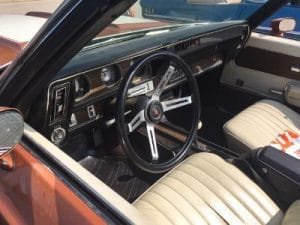
Featured here is a 1971 Oldsmobile Cutlass 442 Convertible.
This was an Olds muscle car built from 1964 through 1987. The numerals 442 meant that the automobile had a four-barrel carburetor on a 330 cubic inch V-8, a floor mounted four speed manual, and dual exhausts.
Oldsmobile did enter the muscle car niche a bit late in the game but there are those that actually think Olds created the first muscle car with it’s 303 cubic inch V-8 Rocket 88 back in 1949.
1971 Oldsmobile Cutlass Styling
The Olds Cutlass was a good looking automobile. In addition to that it offered a degree of luxury. At the same time there were plenty of options available so you could obtain the exact car you wanted.
The 1971 models had an aggressive look to them but also a refined look. The twin grilles had a more square look to them and ran up to the hood and down to the bumper.
A Year Later The Federal Emission and Safety Regulations
It’s interesting to note what effect the new federal emissions and safety regulations had on performance cars. The regulations which came out in 71-72 did it’s best to put a damper on the muscle car performance race during the last half of the 1960’s. Yes, it did slow things down considerably but it did not end it and did in fact reemerge at around 1979. Another factor that worked against the race for higher horsepower with high insurance rates, higher gas prices and unleaded fuel.
The federal safety standards resulted in adding weight to the vehicle thus sapping performance. Among other items this included padded dash boards, safety belts, catalytic converters, air bags, etc. Another result of these changes which were put in place through the years was added cost to the consumer.

1971 Oldsmobile Cutlass 442 Specifications
The base engine for the 1971 Oldsmobile 442 was a 455 cubic inch V-8 with a four barrel Rochester carburetor producing 270 Net HP. There was also the W-30 option with a 455 and four barrel Rochester carburetor producing 280 Net HP. The W-30 option. A variety of six cylinder engines were available but not on the Cutlass Supreme’s which offered only V-8’s.
Available transmissions depending on engine included a three, four and five speed manual along with a Turbo Hydra-Matic three speed automatic.
Dimensions for the Olds Cutlass 442 was a wheelbase of 112.0 inches. Overall length 203.2 inches, width 76.5 inches, height 52.8 inches. Curb weight approximately 3,800 lbs.
Related Auto Museum Online articles are found on the links below..
Reference material for this article included..Oldsmobile Muscle Portfolio 1964-1971 by R.M. Clarke...Cutlass and 4-4-2: Muscle Portfolio 1964-1974 by R.M. Clarke..American Muscle Cars: A Full-Throttle History by Darwin Holmstrom and Tom Glatch.
1971 Olds Cutlass 442 Collector Popularity
 The 1968 through 1971 Olds 442’s are popular collector cars. Among many other attributes the Olds Cutlass was a good looking car whether it’s the hardtop or convertible.
The 1968 through 1971 Olds 442’s are popular collector cars. Among many other attributes the Olds Cutlass was a good looking car whether it’s the hardtop or convertible.
The 1968 model year was when the 442 became a stand alone model. This span of course was mostly prior to the federal emission and safety regulations which means the Olds Cutlass 442 is an excellent representative of the American muscle car era.
It’s important to note that the Olds 442 was actually produced from 1964 through 1991 but with a variety of models, engines and transmissions.
At this date asking and auction prices for a 1971 Oldsmobile Cutlass 442 in excellent restored condition and highly original can be found in a range from about $50,000 to well over $100,000 with convertible models commanding the higher price.
(Article and photos copyright Auto Museum Online)
